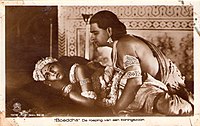
Siddhartha Gautama, most commonly referred to as the Buddha, was a wandering ascetic and religious teacher who lived in South Asia during the 6th or 5th century BCE and founded Buddhism.

Siddhartha: An Indian novel is a 1922 novel by Hermann Hesse that deals with the spiritual journey of self-discovery of a man named Siddhartha during the time of the Gautama Buddha. The book, Hesse's ninth novel, was written in German, in a simple, lyrical style. It was published in the U.S. in 1951 and became influential during the 1960s. Hesse dedicated the first part of it to Romain Rolland and the second part to Wilhelm Gundert, his cousin.
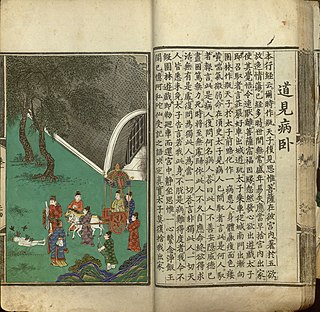
The four sights are four events described in the legendary account of Gautama Buddha's life which led to his realization of the impermanence and the ultimate dissatisfaction of conditioned existence. According to this legend, before these encounters Gautama Siddhartha had been confined to his palace by his father, who feared that he would become an ascetic if he came into contact with sufferings of life according to a prediction. However, his first venture out of the palace affected him deeply and made him realize the sufferings of all, and compelled him to begin his spiritual journey as a wandering ascetic, which eventually led to his enlightenment. The spiritual feeling of urgency experienced by Siddhārtha Gautama is referred to as saṃvega.
Rāhula was the only son of the Siddhārtha Gautama, and his wife, princess Yaśodharā. He is mentioned in numerous Buddhist texts, from the early period onward. Accounts about Rāhula indicate a mutual impact between Prince Siddhārtha's life and the lives of his family members. According to the Pāli tradition, Rāhula was born on the day of Prince Siddhārtha's renunciation, and was therefore named Rāhula, meaning a fetter on the path to enlightenment. According to the Mūlasarvāstivāda tradition, and numerous other later sources, however, Rāhula was only conceived on the day of Prince Siddhartha's renunciation, and was born six years later, when Prince Siddhārtha became enlightened as the Buddha. This long gestation period was explained by bad karma from previous lives of both Yaśodharā and of Rāhula himself, although more naturalistic reasons are also given. As a result of the late birth, Yaśodharā needed to prove that Rāhula was really Prince Siddhārtha's son, which she eventually did successfully by an act of truth. Historian H.W. Schumann has argued that Prince Siddhārtha conceived Rāhula and waited for his birth, to be able to leave the palace with the king and queen's permission, but Orientalist Noël Péri considered it more likely that Rāhula was born after Prince Siddhārtha left his palace.

Himanshu Rai, one of the pioneers of Indian cinema, is best known as the founder of the studio in 1934, along with Devika Rani. He was associated with a number of movies, including Goddess (1922), The Light of Asia (1925), Shiraz (1928), A Throw of Dice (1929) and Karma (1933). He was married to actress Devika Rani Chaudhuri (1929–1940).
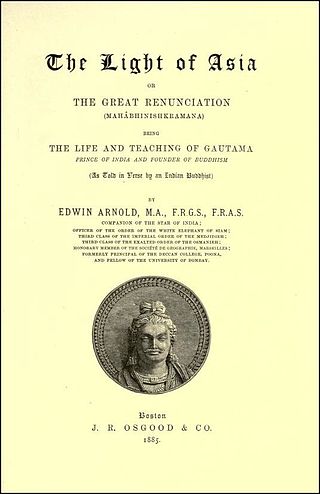
The Light of Asia, or The Great Renunciation (Mahâbhinishkramana), is a book by Sir Edwin Arnold. The first edition of the book was published in London in July 1879.
Franz Osten was a Bavarian filmmaker who along with Himansu Rai was among the first retainers of Bombay Talkies. Osten partnered with Rai on a number of India's earliest blockbuster films like Achhut Kanya and Jeevan Naiya.
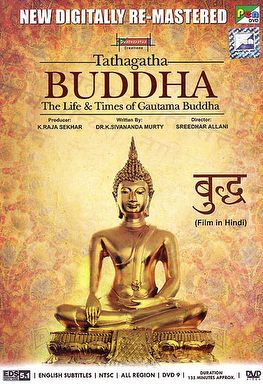
Tathagatha Buddha: The Life & Times of Gautama Buddha, also known as Gautama Buddha and as The Path Finder, is a multilingual feature film on the life and times of the Buddha directed by Allani Sridhar and is based upon the story by Sadguru Sivananda Murty. The film was released in 2008.
The life of Siddhartha Gautama, the Buddha, has been the subject of several films.

A Throw of Dice is a 1929 silent film by German-born director Franz Osten, based on an episode from the Indian epic Mahabharata.
The Buddha was born into a noble family in Lumbini in 563 BCE as per historical events and 624 BCE according to Buddhist tradition. He was called Siddhartha Gautama in his childhood. His father was king Śuddhodana, leader of the Shakya clan in what was the growing state of Kosala, and his mother was queen Maya. According to Buddhist legends, the baby exhibited the marks of a great man. A prophecy indicated that, if the child stayed at home, he was destined to become a world ruler. If the child left home, however, he would become a universal spiritual leader. To make sure the boy would be a great king and world ruler, his father isolated him in his palace and he was raised by his mother's younger sister, Mahapajapati Gotami, after his mother died just seven days after childbirth.

SeetaDevi (1912–1983), born Renee Smith, was one of the early stars of silent films in the Indian film industry.

Gagan Malik is an Indian actor and Buddhist activist. He won the Best Actor Award in the World Buddhist Film Festival organised by the United Nations for his role as Lord Buddha in Sri Siddhartha Gauthama. Malik is known for his leading role as lord Rama in Ramayan.
Buddha — Rajaon Ka Raja is an Indian classical drama on Zee TV and DD National, produced by Bhupendra Kumar Modi, under the banner Spice Global. The creative producer of the show is Shetall Singh. The show first aired on Sunday, 8 September 2013 on Zee TV and Doordarshan. The programme stars Kabir Bedi in a cameo role as Asita Muni, the sage who announces the coming of Gautama Buddha. The story of the serial is based on the life of Gautama Buddha that shows how a prince, Siddhartha, became a Buddha. The role of Mayadevi - scheduled to be played by Sameksha Singh - was replaced with Deepika Upadhyay. Himanshu Soni played the lead role of Buddha, while 2010 Miss India top ten finalist, Kajal Jain played Siddhartha Gautama's wife Yaśodharā. Earlier, Ashutosh Gowariker wanted to collaborate with Shekhar Kapur for a television series on Buddha.
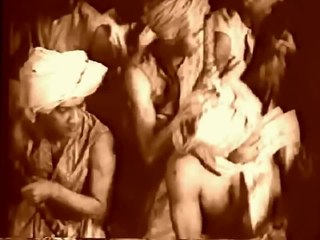
Karma is a 1933 bilingual film starring Devika Rani and Himanshu Rai. The film was directed by J.L. Freer Hunt and was a joint production between India, Germany and United Kingdom. Karma featured a four-minute kissing scene between the lead actors—Devika Rani and Rai—the longest in an Indian film. However, this has been incorrectly reported. The kissing scene features a series of kisses and is less than 2 minutes long.
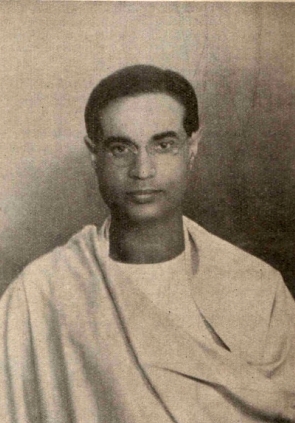
Sarada Charan Ukil was a Bengali actor and artist, known for his role in the movie Prem Sanyas, "The Light of Asia", under the German director Franz Osten. Sarada was the father of Shantanu Ukil, one of the early pioneers of the Bengal School of Art.

Sri Siddhartha Gautama is a 2013 Sinhalese epic biographical film based on the life of the Buddha. Directed by Saman Weeraman Written by, Dr Edwin Ariyadasa, Saman Weersman, Navin Gunarathne and George Paldona.

Shiraz is a 1928 silent film, directed by Franz Osten and starring Himansu Rai and Enakshi Rama Rau. It was adapted from a stage play of the same name by Niranjan Pal, and based on the story of the commissioning of the Taj Mahal – the great monument of a Mughul prince for his dead queen.

The Great Renunciation or Great Departure is the traditional term for the departure of Gautama Buddha from his palace at Kapilavastu to live a life as an ascetic. It is called the Great Renunciation because it is regarded as a great sacrifice. Most accounts of this event can be found in post-canonical Buddhist texts from several Buddhist traditions, which are the most complete. These are, however, of a more mythological nature than the early texts. They exist in Pāli, Sanskrit and Chinese language.
Modhu Bose (1900–1969), was an Indian film director, actor, singer and screen writer during the thirties to sixties. He was born on 12 February 1900 at 63 Dharmatala Street, Kolkata. His mother was Kamala Dutt Bose, an renowned educator who founded the Kamala Girls School at Ballygunge, she was the daughter of Romesh Chunder Dutt. His father was Pramatha Nath Bose, a geologist and palaeontologist who first discovered iron deposits in Jamshedpur and was instrumental in the setting up of Jamshedpur by writing to J. N. Tata about the rich iron ore reserves. Pramatha Nath Bose is credited with the setting up of the first soap factory in India

